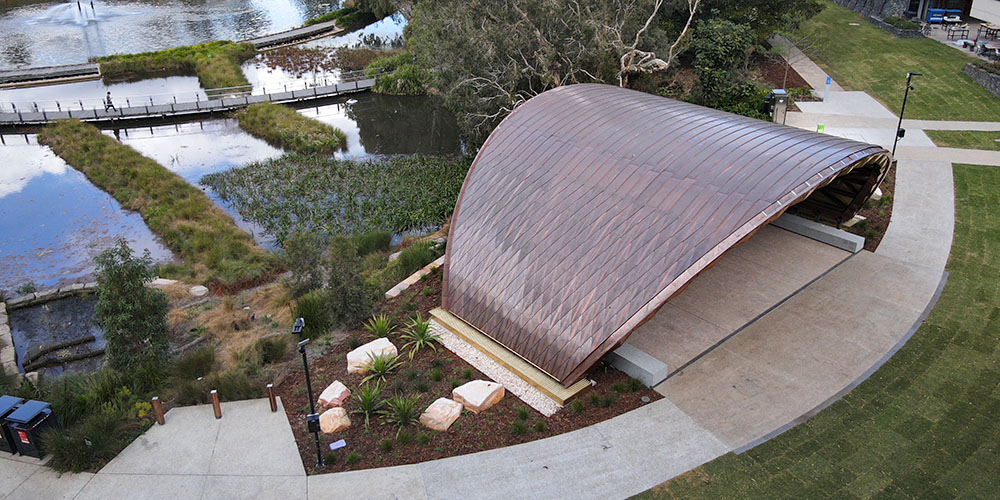UQ lake and amphitheatre renewal
The iconic UQ lake and amphitheatre precinct
is now open for the community to enjoy.
While the ecosystem in the lake is establishing, it is likely algae will appear particularly following warmer weather and periods of heavy rainfall. The algae is non-toxic and is not expected to impact development of the lake’s ecosystem. We will continue to monitor the lake and follow advice from water planning and management specialists.
Located between the UQ Lakes station and Advanced Engineering Building (49), the area aims to enhances the on-campus experience for students, staff and the community with spaces for cultural activities and recreation.
The UQ Campuses on Countries Design Framework has been incorporated throughout the project with native plants and natural building materials, and the creation of outdoor places for people to gather and connect with nature.

UQ's iconic lake
has been revitalised
Vision
The lake project transformed the area into a self-sustaining ecosystem by restoring water health and creating conditions for flora and fauna to thrive.
Work involved de-watering and reshaping the lake, creating recirculating wetlands and installing a capping layer over the lakebed to improve water quality. Throughout the process, native aquatic fauna was safely collected and relocated.
Approximately 8,000 trees, palms and shrubs, and thousands more wetland plants were planted in and around the lake to provide habitat, support a healthy ecosystem and attract native flora and fauna.


Adjacent to the UQ lake, the amphitheatre can be booked for a range of staff, student and community activities and events. For everyday use, it also provides a quiet place for lunch, study or to connect with nature.
The amphitheatre has a seating capacity for up to 400 people and the soundshell can accommodate up to 35 performers on stage.
The amphitheatre is named in honour of Emeritus Professor Dr Mary Mahoney AO for her contributions to the field of medicine and her pioneering role in advancing women in leadership. Dr Mahoney was also a long-serving Senator and the University’s first female Deputy Chancellor.
Within the amphitheatre is an outdoor event venue with a curved roof structure to provide optimal sound conditions for performers by allowing them to hear themselves and others on stage.
The soundshell can be used for performances and leisure and the space must be jointly booked. More information is available online.
For enquiries about booking the amphitheatre, contact PF Assist on 3365 2222 or pfassist@pf.uq.edu.au
As the lake and surrounding ecosystem continues to establish, we encourage the UQ community to respect wildlife and the environment.
The lake is already home to many insects and animals including ducks, turtles and eels. It’s important not to feed or interact with them as this can disrupt their natural behaviours including foraging.
The lake is connected to local waterways and stormwater drains throughout the campus, so it’s important to dispose of rubbish and chemical waste correctly.
With the community’s help, the ecosystem will continue to thrive over time and remain a much-loved part of UQ’s St Lucia campus for years to come.

Project background
Project background
The iconic UQ lake was built more than 70 years ago, prior to much of what we know today about urban water systems. After signs of water quality deterioration in 2018, UQ commenced a project to transform the lake and surrounding area into a self-sustaining ecosystem.
A working group established in 2019 included representatives from UQ and an external expert panel, convened by the International River Foundation. This group developed the design concept with best-practice and commercial knowledge of lake renewal projects in partnership with our design consultants, with experts in engineering, water sensitive urban design, ecology and integrated water management.
The amphitheatre area was previously an underutilised open space. Its renewal provides better access, functionality and visual enhancements to ensure the precinct is enjoyed by the community for many years to come.
The renewal project was aligned with UQ's sustainability initiatives through restoring and maintaining water health, preserving and sustaining flora and fauna, and enhancing the amenity for the community.
The renewed lake and amphitheatre will be a place where people can connect with nature and each other, today and for generations to come.
Questions
Questions
Do you have a question? Email the project team.
